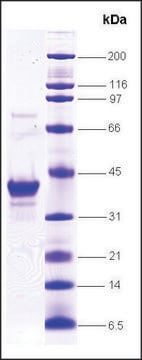ECAS9GFPPR
eSpCas9-GFP Protein
from Streptococcus pyogenes with mutations conferring enhanced specificity, fused with enhanced GFP, recombinant, expressed in E. coli, 3X NLS
Synonym(s):
eSpCas9-EGFP, eSpCas9-GFP
Sign Into View Organizational & Contract Pricing
All Photos(1)
About This Item
UNSPSC Code:
12352202
NACRES:
NA.51
Recommended Products
recombinant
expressed in E. coli
Assay
≥90% (SDS-PAGE)
form
lyophilized powder
packaging
pkg of 1 kit (3 components)
reporter gene
GFP
shipped in
wet ice
storage temp.
−20°C
General description
Recombinant enhanced specificity Cas9-GFP protein from Streptococcus pyogenes (~192 KD) is a ready-to-use reagent for genome engineering experiments. When combined with target-specific guide RNAs, eSpCas9-GFP protein will act as a targeted nuclease suitable for transfection of cell cultures and for the accelerated development of genetically-modified animals via one-cell embryo injection.
An N-terminally fused enhanced green fluorescent protein with an excitation peak at 488 nm and emission peak at 509 nm allows for visualization of transfected RNP complex in addition to utility in flow cytometry applications. The protein also contains three varied nuclear localization sequences postioned for optimal activity.
An N-terminally fused enhanced green fluorescent protein with an excitation peak at 488 nm and emission peak at 509 nm allows for visualization of transfected RNP complex in addition to utility in flow cytometry applications. The protein also contains three varied nuclear localization sequences postioned for optimal activity.
Application
- Functional Genomics
- Target Validation
- Genome Editing
- Fluorescence Microscopy
- Flow Cytometry
Features and Benefits
- Enhanced specificity compared to wild type Cas9
- Highly active
- Ready-to-inject/transfect
Packaging
pkg of 50 μg ( ≥260 pmol )
pkg of 250 μg ( ≥1300 pmol)
pkg of 250 μg ( ≥1300 pmol)
Components
Each kit consists of:
- one vial of lyophilized eSpCas9-GFP recombinant protein
- one vial containing 1 mL of 1x dilution buffer
- one vial containing 1 mL of nuclease-free water with glycerol
Principle
CRISPR/Cas systems are employed by bacteria and archaea as a defense against invading viruses and plasmids. Recently, the type II CRISPR/Cas system from the bacterium Streptococcus pyogenes has been engineered to function in eukaryotic systems using two molecular components: a single Cas9 protein and a non-coding guide RNA (gRNA). The Cas9 endonuclease can be programmed with a single gRNA, directing a DNA double-strand break (DSB) at a desired genomic location. Similar to DSBs induced by zinc finger nucleases (ZFNs), the cell then activates endogenous DNA repair processes, either non-homologous end joining (NHEJ) or homology-directed repair (HDR), to heal the targeted DSB.
Newly engineered eSpCas9 (1.1) enables the efficient targeted gene editing of established CRISPR systems with the benefit of reduced off-target effects. Point mutations (K848A/K1003A/R1060A) in the chromosome-binding motif of SpCas9, as described by Slaymaker, et al., provide higher on-target fidelity without loss of cleavage efficiency.
Newly engineered eSpCas9 (1.1) enables the efficient targeted gene editing of established CRISPR systems with the benefit of reduced off-target effects. Point mutations (K848A/K1003A/R1060A) in the chromosome-binding motif of SpCas9, as described by Slaymaker, et al., provide higher on-target fidelity without loss of cleavage efficiency.
Reconstitution
Lyophilized enhanced specificity S. pyogenes eSpCas9-GFP protein should be resuspended in the Reconstitution solution provided to desired concentration. Gently tap tube to completely dissolve lyophilized powder, incubate for 10 minutes on ice, and spin tube to bring material to bottom of tube.
Other Notes
Use our CRISPR Selection Tool to order gRNA
Check out our other MISSION® Cas9 Proteins at SigmaAldrich.com/CRISPRproteins
Check out our other MISSION® Cas9 Proteins at SigmaAldrich.com/CRISPRproteins
Legal Information
MISSION is a registered trademark of Merck KGaA, Darmstadt, Germany
Storage Class Code
11 - Combustible Solids
Certificates of Analysis (COA)
Search for Certificates of Analysis (COA) by entering the products Lot/Batch Number. Lot and Batch Numbers can be found on a product’s label following the words ‘Lot’ or ‘Batch’.
Already Own This Product?
Find documentation for the products that you have recently purchased in the Document Library.
Customers Also Viewed
Ian M Slaymaker et al.
Science (New York, N.Y.), 351(6268), 84-88 (2015-12-03)
The RNA-guided endonuclease Cas9 is a versatile genome-editing tool with a broad range of applications from therapeutics to functional annotation of genes. Cas9 creates double-strand breaks (DSBs) at targeted genomic loci complementary to a short RNA guide. However, Cas9 can
Kristina Seiler et al.
Cell death & disease, 13(5), 448-448 (2022-05-11)
The family of hexokinases (HKs) catalyzes the first step of glycolysis, the ATP-dependent phosphorylation of glucose to glucose-6-phosphate. While HK1 and HK2 are ubiquitously expressed, the less well-studied HK3 is primarily expressed in hematopoietic cells and tissues and is highly
Patryk Janus et al.
Cell death and differentiation, 27(7), 2280-2292 (2020-01-31)
Heat shock can induce either cytoprotective mechanisms or cell death. We found that in certain human and mouse cells, including spermatocytes, activated heat shock factor 1 (HSF1) binds to sequences located in the intron(s) of the PMAIP1 (NOXA) gene and
Natalia Vydra et al.
eLife, 10 (2021-11-17)
Heat shock factor 1 (HSF1), a key regulator of transcriptional responses to proteotoxic stress, was linked to estrogen (E2) signaling through estrogen receptor α (ERα). We found that an HSF1 deficiency may decrease ERα level, attenuate the mitogenic action of
Our team of scientists has experience in all areas of research including Life Science, Material Science, Chemical Synthesis, Chromatography, Analytical and many others.
Contact Technical Service
















